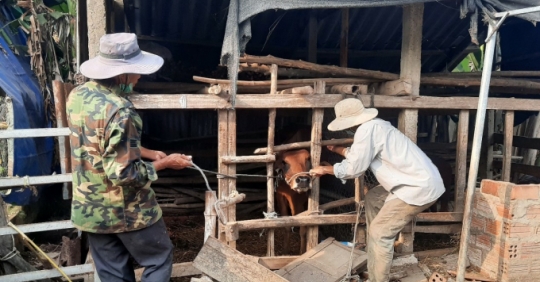Livestock and poultry epidemics have been raging in Quang Ngai province since the beginning of the year. In particular, inflammatory skin diseases in buffalo, cows and African swine fever.

In the last few months of the year, Quang Ngai province is rushing to vaccinate cattle and poultry. Picture: LK
Accordingly, in the past 7 months, dermatomyositis outbreaks occurred in 930 farm households in 222 villages of 73 townships, 8 counties and cities in this province, totaling 1,086 bovine diseases, killing 249 children. At the time of writing, 750 animals have recovered from the symptoms.
African swine fever has also emerged in 25 farm households in 19 villages in 16 townships in 6 districts, cities and townships in Quang Ngai with a total of 459 sick and dead animals.
Mr. Ngo Huu Ha, director of Quang Ngai Provincial Animal Husbandry and Veterinary Medicine Subdepartment, said that although the disease has appeared in the past, it has affected the economy of households and animal husbandry operations compared to other years. In the past, the frequency has increased sick animals removed. In particular, the number of cattle with rash is only 15% compared to the same period in 2021.
In particular, foot-and-mouth disease has not yet occurred in the province. Last year there were 2,400 cattle with this disease. According to Mr. Ha, this result is due to understanding the current livestock situation in the area; Experiences from previous years and proactive vaccination behavior.
“Some places in Quang Ngai have models for beef cows. At the beginning of the year they will buy cattle from other regions and sell them at the end of the year. On this basis, we compiled statistics and created a disease map. After the vaccine is issued, we will ask the provincial people’s committee to extract about 30,000 doses or more for prevention. Before or after the Lunar New Year, they move to epidemic “hot spots,” especially in communities bordering other provinces, so that the locations can take the initiative to vaccinate first,” Ha said.

At present, in Quang Ngai Province, it is still mainly a small-scale household-scale animal husbandry. Picture: LK
Regarding the bird flu epidemic, Mr. Ha said the two diseases that mainly occurred in the area in the first months of the year were influenza A/H5N8 and influenza A/H5N1, but the rate was only 30% in comparison on influenza 2021. Influenza A/H5N8 started reappearing in 2 households in Tinh Hoa township (Quang Ngai city) on April 14, forcing the killing of 2,200 poultry; Influenza A/H5N1 emerged in a household in Tra Binh township, Tra Bong district on April 18, forcing the killing of 2,425 animals.
A representative from Quang Ngai Province’s Livestock and Veterinary Medicine Subdepartment said there will be a potential risk of outbreaks and spread of the disease in the final months of this year, especially at the time of the change of season. In addition, Quang Ngai currently has a large herd of cattle and continues to grow, while small livestock farming still accounts for a large share in the area.
In addition, the proportion of cattle and poultry in the vaccination area is low, many herds are not vaccinated or are not vaccinated; Pathogens circulate at a high rate and on a wide spectrum. Not to mention some diseases for which there is no vaccine; A sharp increase in demand for transport, slaughter and consumption of animals and animal products will also pose a potential risk of disease.

Disease hotspots in Quang Ngai province will be prioritized in vaccination as well as in the implementation of epidemic prevention measures. Picture: LK
Faced with this situation, the Quang Ngai Province Veterinary Sector decided that there was no other way but to encourage vaccination. The focus is on two main diseases that are common in the late season, namely pasteurellosis and foot-and-mouth disease, with priority being given to mountainous regions.
“The number of cows in the mountainous areas of the province accounts for 20% and buffalo for 80%. Minority ethnic groups in mountainous areas often have a custom of grazing rather than grazing and then returning to cages. At this time in August, they bring back buffalo and cows to perform traditional rituals. Therefore, we will seize this moment to vaccinate urgently and achieve the highest efficiency,” said Mr.
According to Mr. Ha, the goal from now until the end of the year is to ensure that 80% of all cattle herds in the region are injected. According to the mechanism of this province, the sub-department of animal husbandry and veterinary medicine is responsible for injecting 40% of the entire stock, and the county budget pays the remaining 40%. In addition, the State Veterinarian is also responsible for advising communities on effective vaccines for districts to order and vaccinate.
At present, Quang Ngai Province has a herd of about 68,000 buffalo, nearly 283,000 cows, 472,000 pigs and over 5.3 million poultry of all kinds. Live meat production has so far reached more than 44,000 tons. The province’s livestock industry is mainly based on small farmers, the whole province has only 81 concentrated livestock farms.

